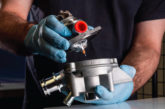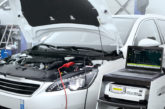
Having a battery go flat in winter is frustrating. Help customers and your workshop by incorporating battery testing into your winter service offering.
Some things to avoid this winter: flat batteries, non-starts, angry customers stuck at the side of the road, wet and snowy roadsides, missed revenue opportunities… to make sure that your winter goes more Ho! Ho! Ho! than Oh! Oh! Oh!, it is important to manage your customers’ batteries, so that the inevitable fall in temperature does not significantly affect battery performance. In extreme temperatures, this performance dip can be as much as 50%.
When motorists succumb to the increased risks of roadside breakdowns and battery related non-starts, independent workshops are inundated with battery issues. PMM has teamed up with Rotronics, the UK’s CTEK and Midtronics partner and battery management industry expert to share with you some simple and speedy checks to build into everyday workshop routine inspections and service inspections.
Ken Clark, Managing Director at Rotronics says: “Independent workshops have a really strong revenue option through battery testing and charging and our data shows a very positive opportunity.
“The increased power demands on a vehicle, due to the darker nights, can create havoc with the vehicle battery and these excessive drains mean that charging every vehicle entering your workshop is vital. The battery is one of the single most important components in a vehicle, yet as part of a routine service, the brakes, oil, tyres, exhaust and all fluid levels are all checked – but not the battery.”
Rotronics now has data from 1.4 million tests from independent workshops and main dealers via the ROBIS portal, which provides an accurate workshop battery test analysis from January 2019 to the present day. This gives us an excellent insight into the pre-, during- and post-covid lockdown periods and the clear opportunities for independent workshops with battery charging.
Ken Clark says: “We know from the ROBIS data, of 1.4 million tests, that 28% of batteries needed charging pre-lockdown. However, during and after lockdown, that number changed to 58% and 57% respectively. Pre-lockdown, the number of batteries that were ‘good’ sat at 62%, however this changed to 20% and 34% during and after lockdown. The number of batteries that needed to be replaced pre-lockdown was 10%. During lockdown it rose to 22% and then reverted back to 9% post-lockdown.
Ken Clark continues: “These data reflect the work that we do with many independent workshops and main dealers. We see a lot of batteries that need attention. This creates a clear revenue opportunity for the independent workshops as we can see that the number of charging opportunities has risen and the number remains high.
“It is more customer-focused and environmentally friendly to not let batteries fail. It is important to do the right thing by your customers. We know through our data that one in every two vehicles needs a recharge. If we build that into the service and repair schedule – charging can be profitable.”
Potential earnings
If we base some opportunity calculations on an imaginary workshop that looks after 100 vehicles per month and consider the costs involved in supplying replacement batteries, the revenue would be:
Pre-lockdown – making £1,500 per month
During-lockdown – £3,300
Post-lockdown – £1,350 per month
If we look at the charging opportunities for that same workshop, the revenue would be:
Pre-lockdown – £280 per month at £10 per charge
During-lockdown – £580 at £10 per charge
Post-lockdown – £570 per month at £10 per charge
The charging option involves no labour, is easy and minimal hassle. You can make the same revenue with recharging and replacing now as you would have been during Covid during the height of battery replacement.
Battery test and charge service
The Rotronics team always recommends that independent workshops offer a simple Battery Test and Charge service for every vehicle that enters their premises. You can then identify all opportunities in supporting your customers and their vehicles with just a few simple steps:
- Test every vehicle’s battery using a diagnostic battery tester, as part of your Winter Inspection Programme
Notify the customer/owner of the outcome, the battery is:
a) Good – fully charged (no action required)
b) Faulty – needs replacing (offer replacement)
Offering this service helps you show your customer how to prevent an issue before it happens. It presents you with additional revenue streams. What to do:
- Visual inspection
Always check batteries for signs of damage, corrosion or lead and clamp damage. - Test and charge batteries
At every opportunity, test and charge and keep the batteries above 12.5V to prevent excessive deep cycling and risk of sulphation. Check the electrolyte levels. - Vehicle health check
Once the batteries are in good, healthy and charged condition, ensure that the charging system is also performing as it should.









